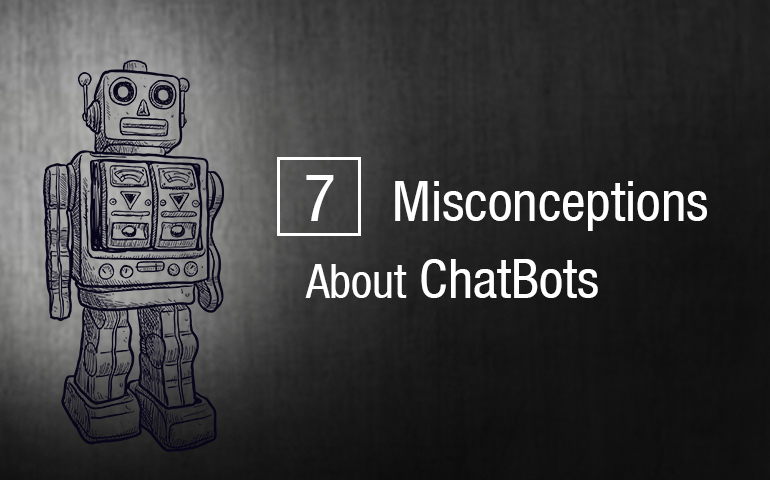Debunking misconceptions about chatbots is important, as there has been a lot of hype regarding chatbots lately. It is necessary to separate the fact from the fiction, so that users do not end up investing time and resources over a dead-end project.
Chatbots are not new as they were invented long time ago, and the first was ELIZA in 1966. Today chatbots with their new capabilities have made users curious about them. Businesses are also showing interest in building a chatbot in order to benefit from increased customer satisfaction.
Many leading brands have already adopted chatbots to remain competitive in the market as chatbots can be useful in many operating areas for various industries. Several businesses are looking to hire chatbot developers but the misconceptions about chatbots are preventing them from implementing a chatbot project and enjoying a healthy ROI out of it.
Let us see a breakdown of some of the current misconceptions about chatbots.
1: Chatbots will replace employees
Talking about chatbots in direct relation with employees is like comparing apples and oranges. Let’s think about chatbots as assistants or helpers rather than replacements. Chatbots were initially created to provide a piece of information to users and hence they were just invented in the form of an interface. Therefore, chatbots cannot replace employees with their functions, and it is not going to happen anytime soon. Chatbots work best when used in conjunction with humans. The easy queries can be handled by a chatbot while the difficult ones can be passed on to a human agent.
2: Chatbots are good enough only for customer service
This is just fiction! Chatbots are here to stay and there are many interesting use cases for them. Chatbots have the capacity to be useful in any industry hence; it is for the designer to map the solution. Some of the relevant examples of chatbots are human resource chatbot, health chatbot, insurance chatbot, real estate chatbot, and news chatbot.
3: Chatbots lack human emotion
This myth is debatable, as some believe that a chatbot cannot converse like a human or rather lacks personalized emotions. There are two ways of looking at it, on one hand chatbots are operated by software, and therefore it cannot give that human emotion to its service providers.
On the other hand, there are chatbots that are trained and programmed to understand gestures and emotions of the user to a deep level. It is a challenge for the developers to try to build a chatbot with more human capabilities but it is possible. An AI-based chatbot can mimic human emotion to a certain level but it is not a good idea to let your users think that they are talking to a real human. It is better to be upfront about the fact that the agent is a chatbot.
4: All chatbots use artificial intelligence
Many are under the misconception that chatbots only work with artificial intelligence (AI). The truth is that not all chatbots use AI currently and in fact some rule-based chatbots may never need to use it.
Companies can choose to have rule-based chatbots that understand the intent and context of the user. Moreover, many enterprises prefer to have chatbots that are easy to build and quick to deploy. In order to serve this purpose, not all chatbots need to be AI-based.

AI-AS-A-SERVICE WORKSHOP
Modern enterprises generate and store a huge amount of structured and unstructured data. This data can be deciphered and converted into valuable insights with the help of AI-powered applications.
5: Chatbots are only text based
It’s a myth! Yes, most of the rule-based chatbots are text based as they are designed for specific services. The fact is that not all chatbots are text-based because voice-enabled chatbots also exist where the user can conduct a conversation via auditory or textual methods.
A typical example of a text-based chatbot is a pizza ordering bot that will provide you information on various types of pizza available, selection of toppings and sauces, and finally a confirmation of the order. Now, let’s take the same example for a voice-enabled chatbot, where the user will have the option to use either text method or voice method.
6: Chatbots will replace apps
At the current rate of adoption chatbots are not expected to replace apps anytime soon. Leading enterprises want to connect with their users on mobile and chatbots seem to be the best way to deliver conversational assistance. Chatbots are the simple way to text and request for information, whereas apps are about downloading and saving data. Furthermore, chatbots offers textual conversational experience and apps stand for visual experiences. It is clear that with their distinct features, chatbots will not replace apps.
7: Building a chatbot is easier than building an app
Building a great conversational chatbot is not easy. Complexities in a variety of segments need to be addressed for the developers such as understanding the purpose of chatbots, designing chatbot conversations, building development platforms, and integrating it with business strategies. In fact, building a dialogue is as challenging as developing a good user interface for an iOS or Android phone.
To finally conclude and come to a point, it is clear that adopting chatbots is a great solution to effectively streamline businesses. Chatbots can easily engage with users in automated conversations on a large scale and benefit the businesses. It is the right time to adopt chatbots technology as an interesting conversational platform and benefit from high ROI. Chatbot for businesses can attract more leads, conversations, orders and sustain the customers for the long term.
We hope this blog has helped demystify some of your misconceptions on chatbots. To know more on chatbot services, please talk to our bot developers.








